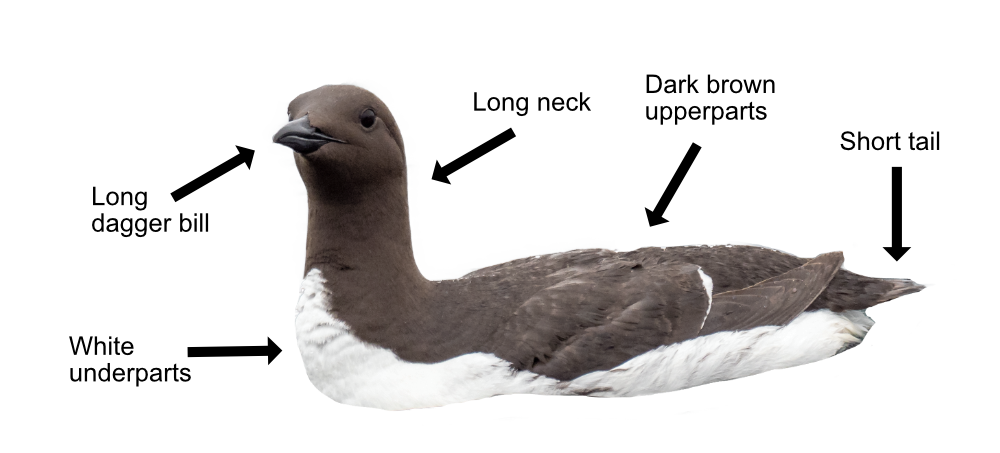
A big fan of Tolkien's Mordor, the Guillemot is our most numerous sea bird and the largest member of the Auk family. A Penguin-like seabird that breeds on sea cliffs between May and July, then spends the rest of the year in loose flocks at sea, similar to Razorbills and Puffins.
Bobbing on the sea, the Guillemot sits long and low looking like a duck. It is larger than a Jackdaw and has a dark brown or black back, white underparts, a long tapering black dagger bill, long looking neck and a short tail. Sometimes there is a spectacle mark around the eye and in winter the neck and lower face turn white. It flies on whirring wings and its legs stick out the back. Their call is a hard growling "aaarr".
Guillemots have a fast direct flight but are not very agile. They become much more manoeuvrable once underwater and feed by chasing fish, often travelling many kilometres to find them. They can dive to depths of 180m, though usually hunt at about 50m. Their favourite fish include cod, herring, sprats, sand eels, as well as shellfish like crabs and molluscs.

Between May and July, they nest in noisy cliff face seabird 'city' colonies, where the cliffs are steepest and most perilous. The courtship display includes lots of bowing, billing, mutual preening, and showing off by standing upright and not falling off. The male points his head vertically and makes croaking and growling noises to attract the females. Pairs, once formed, are largely monogamous. Mum and dad come together each year at the nest site. A single pear-shaped egg is laid on a narrow cliff ledge or flat rock and incubated between mum and dad's feet. The nesting spot may be as near as a bill's length from their neighbours! The egg pattern is unique and helps the parents recognise them. Their odd shape is thought to make the egg less likely to fall off if accidentally knocked. The egg hatches after 20 days and the youngster is fed by both parents for 3 weeks, at which point the 'jumpling' jumps into the sea, as it can't fly properly. Its dense, downy feathers and underdeveloped wings allow it to avoid any serious harm. Dad continues to feed the youngster until it can fly properly 7 weeks later.
There are about 1 million pairs nesting in Britain. Most don't travel far and winter in the North Sea before returning to the same cliff face to breed. With swimming and diving in the sea, they can easily become victims of oil pollution, their main threat.
Their Latin name is 'uria aaige' from the Greek 'ouriaa', a waterbird mentioned by Athenaeus, and the Danish 'aalge' , the Old Norse for 'Auk'. The English name derives from the French 'Guillaume', a form of 'William', not a very frightening name for a Mordor Auk. Another name for a Guillemot is a 'Murre', from the sound of their call, which is much tougher sounding.